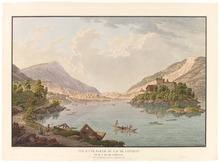
Goldau is a town in the community of Arth, canton of Schwyz, Switzerland. It lies between the Rigi and Rossberg mountains, and between lakes Zug and Lauerz. Well known attractions include the Natur- und Tierpark Goldau[1] and the Arth-Goldau valley station of the Arth-Rigi Bahn connecting to the Rigi mountain.
Goldau is primarily known in Switzerland for its historic landslide, the "Goldau landslide" (Goldauer Bergsturz) of 1806 which killed 457 people. It is also known for its importance for the Swiss railways network, with Arth-Goldau station forming the intersection between the Gotthard, Lucerne, Zug–Zürich and Pfäffikon lines.
YouTube Encyclopedic
-
1/3Views:7 3351 889975
-
4K Arth-Goldau Zugersee Schwyz SWITZERLND アルプス山脈
-
Swiss Trains vol 14 Arth Goldau
-
Goldau Fasnacht 2014
Transcription
Goldau landslide


There were numerous historical landslides in Goldau, with a major event, more significant than the 1806 landslide, dated to the 14th century. The toponym itself, first recorded in 1353, refers to the remnants of these landslides, from a dialectal gol, goleten "gravel, rubble, debris".[2]
On September 2, 1806 heavy rains triggered a landslide from the Rossberg which destroyed Goldau and the adjacent villages of Buosingen, Röthen and Lauerz. The landslide comprised 40 million m3 (52 million cu yd) of material, with a mass of 120 million t (132 million short tons; 118 million long tons).[3][4]
Part of the mass hit Lake Lauerz (which had been created by an even larger landslide in the 14th century), and the resulting tsunami-like displacement wave caused more devastation towards Seewen. The event destroyed 111 houses, 220 barns, and two churches in a disaster area of about 20 km2 (7.7 sq mi), parts of which were covered with debris to a height of 30–70 metres (98–230 ft). It resulted in the confirmed death of 457 people.[3][4]
The disaster inspired the epic poem Goldau by American writer John Neal in 1818.[5] A museum outside the Natur- und Tierpark exhibits findings and photos of the event.[6]
Sport
SC Goldau is the city's football club.
References

- ^ "Natur und Tierpark Goldau" (in German). Natur und Tierpark Goldau. Retrieved 7 September 2015.
- ^ Helen Probst, Gold, Gol, Goleten: Studien zu schweizerischen Ortsnamen (1936), Schweizerisches Idiotikon (1887) II, 216.
- ^ a b The 1806 Goldau landslide Archived 2011-07-06 at the Wayback Machine Bull Angew Geol 2006; 11(2):3-12. English abstract Archived Archived 2017-11-13 at the Wayback Machine
- ^ a b Brockhaus' Konversations-Lexikon. 14th ed., Leipzig, Berlin and Vienna 1894; Vol. 8, p. 125
- ^ Richards, Irving T. (1933). The Life and Works of John Neal (PhD). Harvard University. pp. 215–216. OCLC 7588473.
- ^ "Willkommen im Bergsturzmuseum Goldau" (in German). Bergsturzmuseum Goldau. Archived from the original on 26 April 2019. Retrieved 7 September 2015.
External links
47°2′53″N 8°32′59″E / 47.04806°N 8.54972°E
